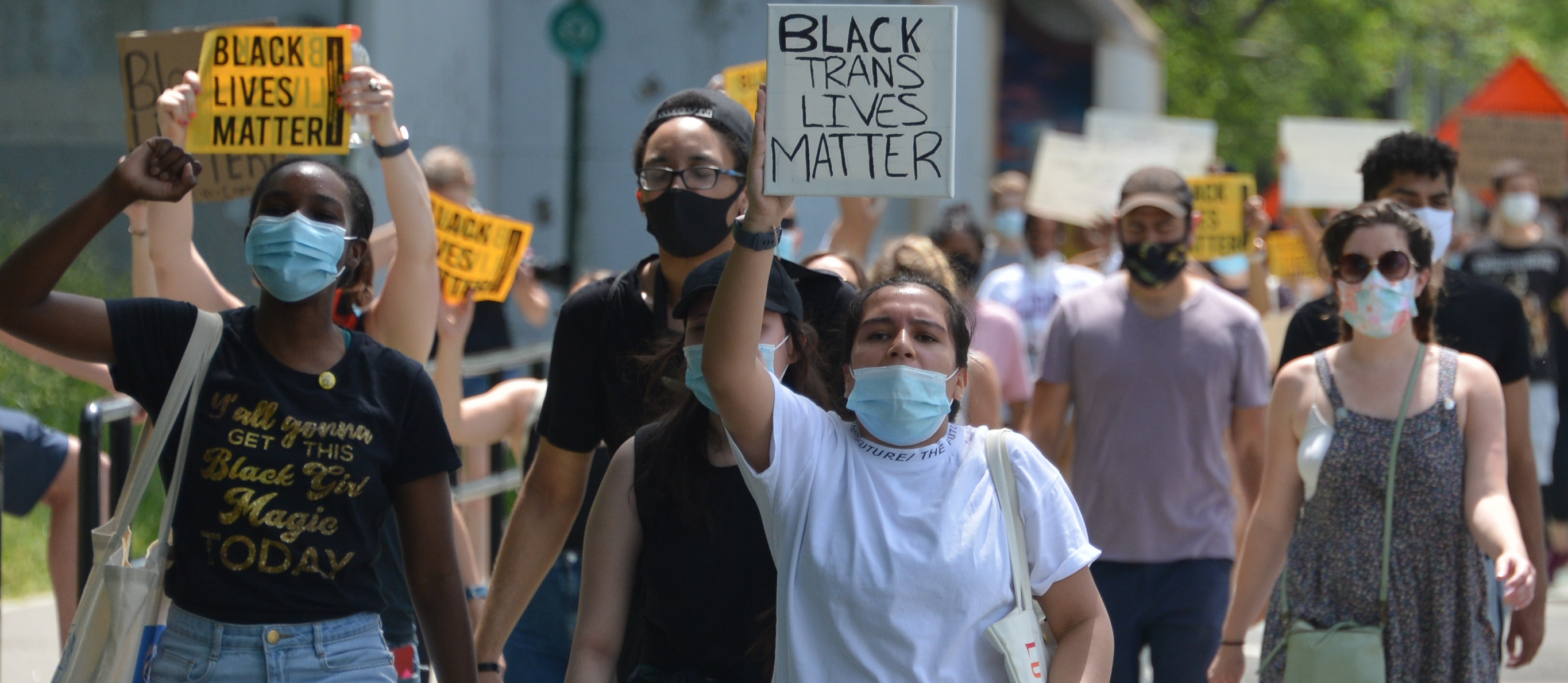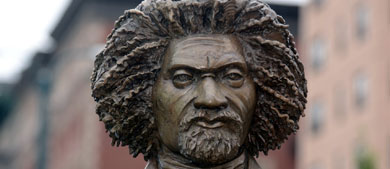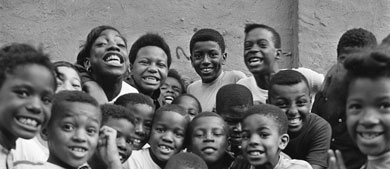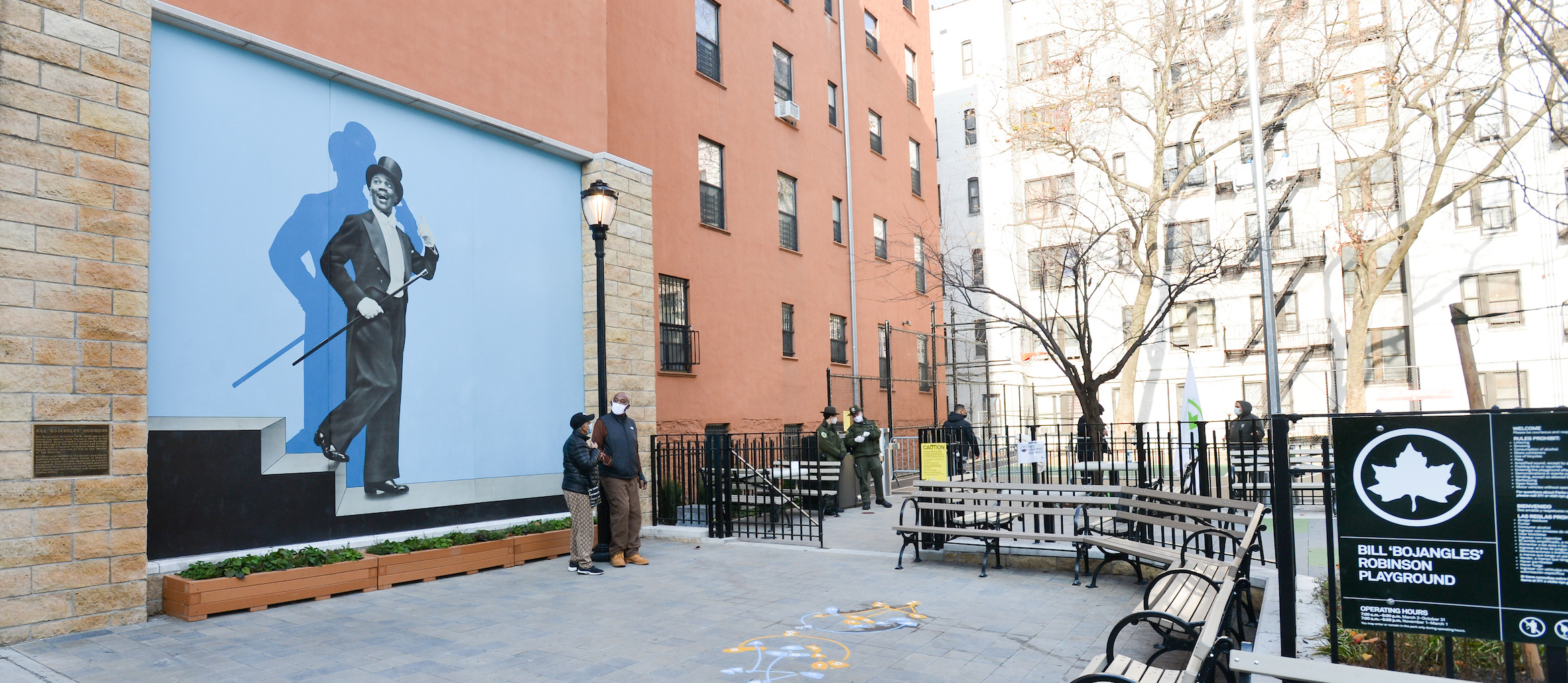Black History in NYC Parks
Learn about the Black experience in the United States and how New York City honors Black history in our parks today.
Black History Month Events and Virtual Exhibits
Celebrate Black History Month at NYC Parks! This February, check out our history tours, art exhibits, and celebrations honoring Black culture, history, and legacy. Find Black History Month events at NYC Parks
Art in the Parks Honoring the Black Experience
Black History in NYC Parks. From monuments of our heroes to sculptures memorializing the Black experience, we’ve many pieces of art in our permanent collection across NYC that commemorate Black history. Here’s a sampling of Art in the Parks honoring the Black experience
Photos: The Black Experience in NYC
Journey through more than 80 years of Black culture in New York City, through the lens of our parks. See photos of African-American life at parks
African-American Namesake Parks
Many parks and playgrounds are named for celebrated African-American people, from community activists to sports professionals, whose lives helped shape the world we live in today. Take a look at NYC Parks’ African-American Namesake Parks
Historic Happenings in NYC Parks
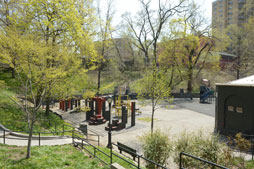
The Birthplace of Hip Hop
On August 11, 1973, hip hop was born in the Bronx at 1520 Sedgwick Avenue at a rec room party featuring Jamaican-born DJ Kool Herc. The party was so popular and crowded, Herc and his sister Cindy Campbell had to move the party over to Cedar Park, at what is now known as Cedar Playground.
Learn more Parks’ hip hop history
Juneteenth Grove
On June 19, 2020, in celebration of Juneteenth, now recognized as a federal holiday, and to celebrate the homegoing of George Floyd, Ahmaud Arbery, Breonna Taylor, and countless others, NYC Parks created the Juneteenth Grove in Cadman Plaza. The grove is dedicated in solidarity with the Black community to the fight to end systemic racism. Learn more about the Juneteenth Grove
New York’s Municipal Slave Market
On Wall Street, between Pearl and Water Streets, a market that auctioned enslaved people of African ancestry was established by a Common Council law on November 30, 1711. This slave market was in use until 1762. Within months of the market’s construction, New York’s first slave uprising occurred a few blocks away on Maiden Lane, led by enslaved people from the Coromantee and Pawpaw peoples of Ghana. Learn more about New York’s Municipal Slave Market
Power to the People: Protests and Demonstrations in NYC Parks
Our parks serve as places of assembly and calls to action. Take a look at photos from a sampling of marches, parades, and protests in our parks, including the protests by the Black Lives Matter movement. View the ‘Power to the People’ virtual exhibit
The Tree of Hope
The original “Tree of Hope” was an elm that stood opposite the famous Harlem Lafayette Theater at 131st Street and Seventh Avenue. The venue was a hot spot for African-American talent and many celebrated performers rubbed the tree for good luck. The tree died but its stump was preserved as a good luck charm. A piece of the trunk from the original elm stands on the Apollo’s stage. To this day, many performers who grace the stage, rub the tree for good luck. Learn more about The Tree of Hope in Harlem
Underground Railroad
Along the Flushing Freedom Mile, a walking tour of historic Flushing in Queens, Bowne House, the site of Aspinwall House, and Macedonia A.M.E. Church are believed to have been stops on the Underground Railroad. The Underground Railroad was a network of sanctuaries for enslaved women and men escaping enslavement in the South to seek freedom in the North.
Historically Black Neighborhoods
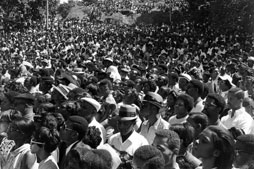
Seneca Village
Seneca Village, which was located from 81st to 89th Streets between Seventh and Eighth Avenues in what is now a section of Central Park, may possibly be Manhattan’s first prominent community of African-American property owners. Beginning in 1825, parcels of land were sold to individuals and to members of the African Methodist Episcopal Zion Church, described as the “largest and wealthiest church of coloured people in this city, perhaps in this country.” In 1853, the state legislature authorized the use of “eminent domain” (the taking of private property for public purposes) to create Central Park.
Learn more about Seneca Village
Harlem
In the early 20th century, millions of Black Americans moved to northern cities, seeking an escape from the racial violence and lack of economic opportunity in the South. Thousands relocated to Harlem in the 1920s through 1930s. This period, known as the Harlem Renaissance, was a golden age marked by an explosion of literature, music, theater, and art, ushering in a new era of Black Pride, accompanied by the creation of cultural institutions in the neighborhood, such as the Apollo Theater, the Savoy Ballroom, and the Cotton Club. The neighborhood would also be known for its historic parks and community spaces, including Morningside Park, Colonial (now Jackie Robinson) Park, St. Nicholas Park, and Mount Morris (now Marcus Garvey) Park.
Learn more about Marcus Garvey Park
Addsleigh Park
Addisleigh Park’s famous residents included jazz musicians Ella Fitzgerald, John Coltrane, Charlie Parker, Illinois Jacquet, James Brown, Milt Hinton, Ray Brown, Earl Bostic, Herbert Mills and Cootie Williams, as well as hundreds of other leaders in music, sports, the arts, and politics. Musician’s Oval in St. Albans Park honors the numerous Black jazz luminaries who settled in the Addisleigh Park, now a landmarked historic district. Learn more about Musician’s Oval
Sandy Ground
Sandy Ground on Staten Island is the oldest continuously inhabited free Black settlement in the United States. Several of the community’s historic structures are still extant, including five that have been designated as New York City landmarks. These landmarks include a church, a cemetery, and three homes. There are some residents who still live in the original community. In 2020, Fairview Park‘s wooded area was named Sandy Grounds Woods in its honor. Learn more about Sandy Ground Woods
Weeksville
After the abolition of slavery in New York State in 1827, Brooklyn became a popular settlement area for freed Black people. Until the late 1800s, Weeksville, at the junction of modern-day Bedford-Stuyvesant, Crown Heights, and Brownsville, became a growing African-American community and home of prominent Black professionals, including New York’s first Black physician. Though the dynamic of the neighborhood has since changed, remnants of the historic neighborhood are memorialized in the historic houses, the Hunterfly Road Houses, and nearby Weeksville Playground.
Learn more about Weeksvile
African-American Burial Grounds
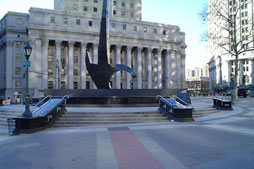
Foley Square
In 1991, construction workers rediscovered what is now the New York City African Burial Ground in Manhattan, where as many as 10,000 men, women, and children were interred in the graveyard from the 1690s to 1794 during slavery. Today, the area, which includes Thomas Paine Park, is home to many memorials to enslaved Africans and the African diaspora. In 1993, the burial ground became a National Historic Landmark. Learn more about the African-American Burial Ground in Manhattan
Enslaved African and Kingsbridge Burial Grounds at Van Cortlandt Park
The area adjacent to the Kingsbridge Burial Ground has been identified as a possible burial site of enslaved African Americans who lived and worked on the Van Cortlandt plantation and were responsible for most of its functions. The information gathered is inconclusive, but it is likely that this site is the location where enslaved people were interred. The space is honored with a dedicated sign. Learn more about the Enslaved African and Kingsbridge Burial Grounds at Van Cortlandt Park
Enslaved African Burial Ground in Drake Park
Separated from their masters’ graves, dozens of enslaved Africans were interred beyond the consecrated ground of Drake Cemetery in the Bronx. The last burial in the Enslaved African Burial Ground reportedly occurred in the 1840s, when the former Leggett slave Aunt Rose was laid to rest next to the enslaved family members and friends with whom she grew up. The Enslaved African Burial Ground was graded away and covered with dirt, gravel, or asphalt sometime in the early years of the 20th century succumbing to roadway construction and development prior to the park’s establishment. In 2013, a local history education project conducted with school children at nearby P.S. 48 unearthed much of this forgotten historical chapter. Learn more about the Enslaved African Burial Ground in Drake Park
M’Finda Kalunga Garden
This garden in Sara D. Roosevelt Park was once an African-American burial ground that was used in the late 18th and early 19th century, after the African burial ground near city hall closed in 1794. Learn more about M’Finda Kalunga Garden
The Olde Towne Flushing Burial Ground
In the late 1800s, the African Methodist Episcopal (AME) Church had run out of burial space and urged the town of Flushing to reserve a public burial ground for their use. Some 62 percent of the people buried here were Native American or African American, including The Bunn family—whose names appear on the only marked gravestones we know of from this site. Learn more about The Olde Towne Flushing Burial Ground
Sankofa Park
During the 17th century this site housed the Dutch Reformed Church schoolhouse and cemetery. The “old cemetery” was established around 1680, and circumstantial evidence indicates some free and enslaved African Americans were buried here. In 2016, NYC Parks commissioned a series of archeological surveys, which unearthed fragmentary human remains. In July of 2019, community members held a ceremony to reinter the human remains found during the archeological surveys. At this event the site was renamed Sankofa Park. Both a word in the Akan Twi language of Ghana and a Bono Adinkra symbol, Sankofa refers to a mythic bird that flies into the future while keeping its beak turned toward the past. Its translation tells us that “it isn’t taboo to go back and fetch what you forgot.” Learn more about Sankofa Park

